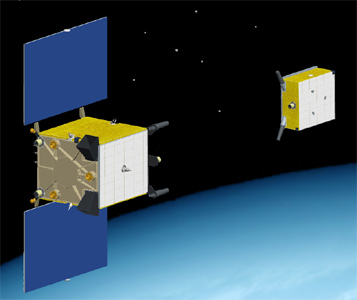PRISMA (original) (raw)

PRISMA [SSC]
PRISMA (Prototype Research Instruments and Space Mission technology Advancement) consists of two space vehicles, the Main spacecraft and a simpler Target craft that will meet in space. The Main spacecraft can manoeuvre while the role of the Target is just what is in its name.
The Main craft will weigh about 140 kg and the target about 40 kg. They were launched together as one unit and the Target craft separated after about two weeks in orbit when the technology demonstration commences.
The Swedish Space Corporation is the prime contractor for PRISMA. Major subcontractors in Sweden will be Saab Ericsson Space (electronics, structure, separation systems, cable harness), Omnisys Instruments (power system) and ECAPS (propulsion system).
The PRISMA Rendezvous Robot composite was launched on a Dnepr rocket in 2010 as a piggyback passenger with other spacecraft. The intended orbit is a sun-synchronous dawn/dusk orbit at about 600 km altitude. The PRISMA demonstration phase is intended to last about 8 months. Satellite control will be performed from SSC's Esrange ground station while mission planning and evaluation will be carried out from SSC's space engineering centre in Solna outside Stockholm. Operations will be highly automated and experimenters in various space organisations will monitor and control their equipment from their home bases via the Internet. Total program costs excluding the onboard equipment supplied by the partners from other countries than Sweden but including spacecraft development launch and operations is 20-23 million euros.
The main objective of PRISMA is to carry out flight demonstrations using experimental manoeuvres requiring new GN&C (Guidance, Navigation & Control) and sensor technologies for future rendezvous and formation flying missions:
- Highly autonomous GN&C experiments. The two craft will perform autonomous formation flying. The Main craft will locate the Target at a long distance, approach it, fly around it and then leave it. SSC with assistance from the German space organisation DLR will perform this test.
- A GPS-based navigation experiment from DLR will evaluate the use of GPS as a sensor for automatic formation flying.
- An optical sensor based on star tracker technology will be evaluated as a tracking and rendezvous/docking sensor. This experiment is a joint venture between the Danish Technical University and SSC.
- A flight qualification test of a radio frequency metrology formation flying package intended for ESA's Darwin project. Alcatel Space, France is responsible for this experiment with support from the French space agency CNES.
PRISMA also tested technology developed by Swedish companies in the frame of Sweden's space programme:
- To space qualify a new satellite propulsion system using non-toxic propellant, HPGP (High Performance Green Propellant), developed by the ECAPS company, jointly owned by SSC and Volvo Aero. The development of this system, intended as a replacement for hydrazine-based thrusters, is also supported by ESA.
- To flight qualify new avionics and power systems derived from the corresponding systems on ESA's SMART-1 lunar probe, developed by SSC. PRISMA avionics is designed by SSC and the power system by Omnisys instruments in Gothenburg. Saab Ericsson Space will manufacture the avionics.
- To qualify new onboard software using Matlab/Simulink and automatic code generation to an even higher degree than in the SMART-1 project. SSC is responsible for developing this software.
- To test SSC's new Electrical Ground Support Equipment and Satellite Control software system.
- To test silicon-based cold-gas microthrusters developed by NanoSpace AB, a Swedish company owned 75% by SSC and 25% by Swedish space technology innovator Lars Stenmark.